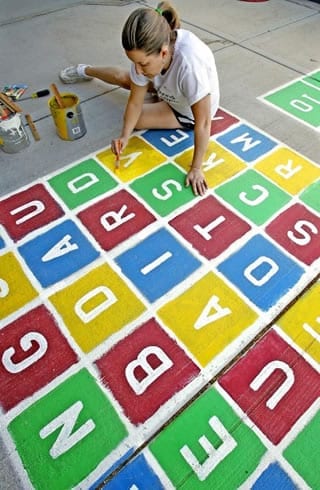Schools throughout district utilize program that encourages problem solving and play
 Most people don’t think “conflict resolution” when looking back on their childhood playground experiences, but students in several Marana Unified School District Schools might end up doing just that.
Most people don’t think “conflict resolution” when looking back on their childhood playground experiences, but students in several Marana Unified School District Schools might end up doing just that.
Peaceful Playgrounds is a series of age-appropriate games and learning activities that are painted onto existing playground surfaces using blueprints and pre-fabricated stencils, and with it students are finding there’s always something to do at recess – and they’re learning to solve their own problems while they’re at it.
Twin Peaks Elementary, 7995 W. Twin Peaks Road, was the first Marana school to put the program in place, in January 2009.
It was followed soon after by DeGrazia Elementary, 5051 W. Overton Road, and this school year began with a brand-new Peaceful Playgrounds setup at Butterfield Elementary, 3400 W. Massingale Road.
Californian Melinda Bossenmeyer founded the Peaceful Playgrounds company in 1998 after spending 27 years working in the public education system.
When she formed the program, she was an elementary school principal.
Playground disagreements spilled over into the classroom when students returned from recess, making it difficult to teach, she said.
She identified five problems to which she could find solutions, she said:
- Students didn’t have good skills to solve problems.
- There wasn’t enough equipment for everyone. “Even though children wanted to participate in games, they didn’t have the equipment needed to do so,” she said.
- The adults in charge had inconsistent expectations and consequences for the students.
- Children know different rules for different games, often leading to disagreements.
- There weren’t enough activities for children, leading to boredom and frustration.
She began asking children who played peacefully day after day about the games they were playing and what the rules were.
Eventually she formulated Peaceful Playgrounds, which she said has been implemented in 8,000 schools nationwide.
A typical setup costs $4,000 and includes a curriculum, paint machine and paint, stencils, 200 pieces of equipment such as beanbags, balls and jump ropes, instructional DVDs to show the students and activity guides that outline consistent rules to teach.
Before being set loose with the activities, students go through brief training on each game so they all understand exactly how to play and what to do if there’s a disagreement.
And any time someone new asks if he or she can play, the answer is always “yes.”
The Marana schools’ Peaceful Playgrounds programs were funded mainly by the Safe and Drug-Free Schools Program – also known as Title IV – which is a federal program for reducing violence and the use of drugs, alcohol and tobacco through education and prevention activities.
The schools’ student councils covered the rest. Teachers and school families helped paint the games onto the playgrounds.
Twin Peaks counselor Shari Attebery was able almost immediately to track the difference in student behavior after the new program arrived.
The school didn’t have Peaceful Playgrounds during the first semester of the 2008-2009 school year, and during that time there were 14 peer mediations and 24 bully reports, she said.
The second semester, there were eight peer mediations and 12 bully reports.
Of the 36 total bully reports, the vast majority – 27 – were not bullying issues but conflict-resolution matters, Attebery said.
Peaceful Playgrounds teaches children to “walk, talk or rock,” said Patricia Abbuhl, associate principal at Butterfield.
In a conflict, children can walk away, talk it out, or settle it with “rock, paper, scissors.”
Abbuhl said she, too, has noticed a difference in the children just in the short time Butterfield has had its Peaceful Playgrounds setup.
“The biggest thing is, they’re having fun,” she said.
Fifth- and sixth-graders used to just wander around and talk, while the younger kids would chase each other, because there wasn’t enough playground equipment for everyone.
“What we didn’t expect was that the older kids made better use of them (Peaceful Playgrounds) than the younger kids,” she said.

